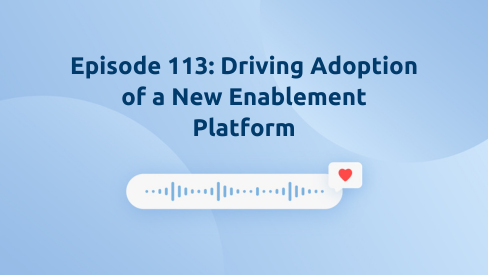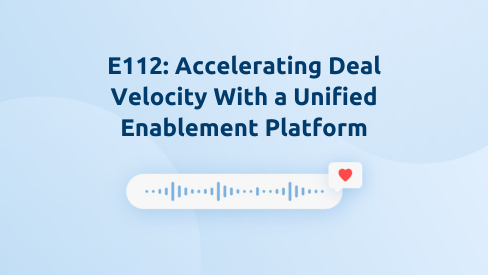According to Salesforce research, 66% of sales representatives feel overwhelmed by the number of tools they use. So how can you streamline your tech stack to enhance operational efficiency and drive revenue growth?
Shawnna Sumaoang: Hi, and welcome to the Win Win podcast. I am your host, Shawnna Sumaoang. Join us as we dive into changing trends in the workplace and how to navigate them successfully.
Here to discuss this topic is Serge Lobo, the Chief Revenue Officer at Loadstone. Thank you for joining us. I’d love for you to tell us about yourself, your background, and your role.
Serge Lobo: Thank you, Shawnna. Thanks for having me here today. What is this year today? So I’m 27 years in sales, 23 years in sales management.
I used to work for multiple different known brands like Microsoft, HP, Pegasystems, Ingenico, and SAS, so that’s a famous analytics company. And now I’m chief revenue officer, so we try to get The right title for my position because nowadays in size business, the revenue comes not only from sales, but also from retention of the customers.
So my role is actually to wrench all the sales processes and ensure that the customers are getting the right impact so that we managed to retain them and then ensure that they grow together with us.
SS: Amazing. Well, thank you again for joining us today. Given your extensive experience in sales leadership across both large enterprises and startup organizations, I’d love to understand how does your background influence your strategy for driving global revenue growth at Loadstone?
SL: I play the thinking first of all, so before making any moves, any discussion. So we need to think of what do we want to achieve here rather than just get the contract. Yeah, it’s not as simple as it used to be when you get a call and then just because you have a fascinating piece of software, someone getting excited and then just signs the contract.
Not anymore. A lot of competitors, like in our space, we just made a rough calculations and we had. We counted like 14, 000 companies worldwide that are doing pretty much the same things as we do 14, 000. Yeah, that’s a lot. And, uh, the concept that I apply is that first of all, so we need to think of how we drive the process and then go after automation of that.
So we need to design the processes. We need to get to build the operating model, and then we need to understand the requirements for the systems for the systems that we want to deploy and to benefit from them. And of course, well, all that. Goes through the, uh, revenue thinking. I’m a chief revenue officer.
So I’m partially responsible not only for revenue, but also for spendings. Yeah. So spendings are also the key elements. So every solution that we’re using should be cost efficient for us.
SS: Amazing. And I understand Lodestone recently went through a rebrand, which can bring a lot of significant changes for the sales team.
What are some of your best practices for helping your teams effectively navigate this transition?
SL: Well, first of all is, uh, we need to be transparent. Yeah. We need to be transparent and we need to make sure that the team buys the general idea. And then the team is ready for change. Cause as for any human being, the change is the biggest challenge.
Yeah. So after five years old, so then we are really hesitant to change, which is surprising before five years, we want to try everything. You want to change everything like every day. After we are five years old. So we become really hesitant to that. That’s pretty much the major challenge that we have when we change anything in the company.
We won’t change the sales process and we need to sell that first to people. And sometimes it’s, it’s not an easy task. And so we try different means of getting that to people so that they start to use that. It’s because it’s not only to make. People try to stand that, right? But it’s also like, do you use that in like everyday work?
Do you use that in everyday customer discussions? Do you use that when you talk to your peers? And so that’s most difficult. And so we spend a huge amount of time now in terms of like getting them to people so that they start using that. Yeah. Cause we have people from different generations, different background, different experience.
And so of course, well, they try to use the experience first. All right, so we are now in Lodestone. Okay, so what’s your product, product X, Y, Z. All right, let me try to sell that. And then we need to make sure that people are doing that in the right way. Yeah. Cause we see that there is a best practice and there’s some practices that have very little propensity to be successful.
Yeah. So we need to increase that chance. We need to give people not only the automation tools, but also the methodology and the process tools so that they speak in the right way to the customers.
SS: Absolutely. And as you mentioned, when these organizational changes happen, you often have to reshape the sales process.
And I know that’s one of your key focuses. What challenges have you faced in optimizing sales processes and how have you overcome them?
SL: Well, the first is to measure the measurement of the current status and the measurement of the target status, say in my career when they try to do the major change, so then people want to move fast.
Yeah, okay So let’s move fast. Let’s change everything Let’s do it for the best But then when we try to analyze and to think on what will be a successful change. Then we need to define the target where we are today where we want to go in the future And that’s the number one thing. Then the second thing is really to get people involved into that change.
And what I do usually throughout my career since my early management years, so I try to involve people, you know, so involving people into designing that process because they know about what’s going on in the field and then they know better what might work in order to do it best. Yeah. And then of course, well, if there are some good people with different experience also, but different attitude to the process.
So they usually get some really good insights and really good advisors and me as a manager. So I usually facilitate that process, even though I might know the final answer. So, but I then guide people to the final answer, which is right so that they cannot escape them from deploying that and usage of those process, those ideas, those guidelines that they designed literally for themselves.
SS: I think those are some great best practices now from your perspective, what is the strategic advantage of an enablement platform and helping organizations improve sales processes and really drive operational efficiency?
SL: Some years ago, I heard that statement when the boss asked, what if we enable people teach them to do and they leave? And then the sales manager answers that question with another question.
What if we don’t enable them? We don’t teach them and they stay. So that’s literally it. So that’s a key element of any successful sales organization to enable people, not only of the product knowledge, not only of the pricing tools, but the way you sell that, because nowadays this is not a challenge to sell something.
It’s in fact, the challenge, the huge challenge is to buy, and if we analyze the customer processes, then we will find out that the process to buy something is by far more complicated than the process to sell something. And so we need now to understand and to guide our salespeople, to be the helper in that journey, for the customer to fulfill their buying intentions, to fulfill their buying process in the best way, because well, they buy it once, but we sell it like on a multiple times.
And so we now. What are the intentions of the customer in the process of what will be the next step? How to justify this or that step, justify this or that number. Yeah, so all of those talking to people in numbers, talking to people in financials that requires a huge amount of routine operations and a huge amount of experience.
So you need to be very comfortable to do that. Yeah, and in order to do that, you cannot do that on the fly. So you need to be enabled properly. You need to be enabled through the business cases. You need to be enabled through the rehearsals of the pitches. You need to be enabled through the templates. And of course, all of that, the combination of all those streams.
So it becomes kind of the most important part of the, uh, in the company, because all the rest is just the outcomes on how good your people are trained, how good people are enabled if they’re not. There’s a very little chance that they form well and you build up the sustainable system of sales, a sustainable organization.
And that’s why actually, so the first thing I did in Loadstone, when I joined the company, I asked, do we use any kind of database or knowledge base enablement system? Do we have any enabling processes for people who come to Lodestone, who come to, uh, to join our great team and, uh, make sure that we multiply our, Successful cases and best practices.
And the answer was like, well, really, so yeah, we got some Google Docs, multiple slides for people trying to serve there. And, um, literally, so they, sometimes they just get drawn in those multiple artifacts and never, never came up. So that’s why we decided for a different approach.
SS: Well, I love that you’re taking that and from a sales leader perspective, what role does leadership play in really fostering a culture of efficiency?
SL: Let me give you an example. So for every single new employee that comes into a client facing role, I spend at least four and a half hours of my time for every single employee, not a group level, like on individual level on getting people through our operating model. How do we work on getting people known?
What do we sell on getting people know? What are the major tools that I’m looking as a zero on the management? So means that We try to get our employees, our sales or client facing people, not only through the tools, but also through the cultural DNA. So what the company is, what are we doing? Well, why are we doing this?
Why we don’t do that? Why we don’t push in the products? Why I didn’t need the contract without knowledge of the customers? Yeah. Because sometimes, well, there are people who come up to and say, Hey, here’s a contract. I just signed it. I said, do you have enough information about that customer? Well, who cares?
Yeah, I just signed the contract. Well, I do care because, well, there’s a little chance to retain that customer in one or two years just because, well, we did the last job during the sales process. No, that’s not the DNA of the company, and we explained that right from the beginning of the employee journey in our company.
SS: I love that. I love that’s part of the DNA. Now, you mentioned that automation has played a key role in helping you drive operational efficiency, such as your automated process for content governance. Can you tell us more about this process and how you’re automating sales workflows?
SL: Well, the sales workflows are being automated with a solution from the company called Pipedrive.
So that’s our sales automation tool. But everything aside of that, so it means the knowledge base and some parts of the customer interaction workflows, including learning and management, we are automating that with Highspot. So we’ve came across Highspot a couple of years ago. And so I found it really fascinating because I know in my previous companies we’ve had.
Self enablement platforms. And that time I was like thinking, okay, so we don’t have enough resources to develop anything, which would be at least at the level of what I used to have in my previous companies. And then I came across Highspot and I was like, really? So can these guys do this and this and this?
And then we came through a couple of use cases and then we understand, okay, so Highspot is a good, probably a good selection for us. And then when I understood that this is a great selection for us is that when we start talking money. Cause this was literally like the, the only provider who managed to convince me from the money standpoint, from financial standpoint, rather than the features and functions.
So, and that’s still the example for, even for my salespeople, I still have that first proposal from Highspot saying, all right, so this is how the proposal should look like for, for our customers, because that speaks in terms of financials, mostly rather than features and functions. Then that impressed me a lot.
And so I understood that company wise, we have pretty much similar DNA. Because we also talk to our customers, not for features and functions, but through the benefit that they may get from usage of our software.
SS: Well, I have to say, you guys are doing amazing with streamlining those processes. And you’ve also driven really strong engagement from the sales team with 95 percent recurring usage and Highspot.
What are some of your best practices for driving adoption of these investments that you’ve made in tools for your sales team?
SL: Well, first of all, what I was impressed at the beginning is how I might use that for customer interactions. So the functionality of what they call the pitching and that transformed into creation of Digital Rooms.
So that allows us to create a very personal lending. Content page for all customers. So whenever I want to share something with the customers, I make my people to share that through the pitching of the Highspot because I can definitely say whether this content was attractive or not, whether this content was read, how much time was spent in reading of that content?
Because that’s very important for me. And I had a couple of times I even had some nasty customers had a situation when, you know, me personally, I was sending them the pitch and then I called them and said, hey, we spend a time, we prepared a proposal for you. Well, what do you say? He said, well, um, I read this proposal.
I never saw that being opened and we don’t go, okay, all right. So I don’t want to spend the time with you just because, well, it doesn’t make sense for you. Okay. If it doesn’t make sense for you, it doesn’t make sense for us, but pitching is a very important part of custom interactions and that drove a lot of ROI for us.
Because we now see that those customers who are mostly interacting with this landing pages, personal landing pages, they close the deals with us quite fast. So then the second one is, of course, for the internal knowledge base. So we found that those people who are most readers in Highspot, they are, surprise surprise, our top performers, yeah? Because in a lot of cases, you might face this situation when you just create some kind of piece of content and then you ask your people to read this, read this, listen to this, watch this, and then say, well, listen, well, I don’t have time, I have a custom meeting, I don’t have time, it’s just too long, can you just make it one page of me?
And the bottom line, those who read most are the top performers. What a sequence, yeah? So that structure actually helps us to build up the sales guides to check what are the most useful pieces of information that we have in a high spot, also from to spend the time on developing or stop developing certain pieces of content at a time.
SS: Absolutely. Absolutely. Those are amazing. And since implementing Highspot, do you have any business results that you can share or any wins that you can share?
SL: Well, in fact, it’s really hard to measure the effectiveness of sales enablement rather than through the sales results. And so I know for sure that we increased our conversion rates by 110%.
So that’s, that’s the official number from our Pipedrive. So just getting prepared for the session, I asked the CRM team, what’s the result or what do we have from numbers? And it told me, well, we have this and this and this. And I think, well, this is the highest award for me. To understand what’s the efficiency of Highspot in Loadstone.
Yeah, 110 percent of onversion growth. And, we have today, I think, over 7, 000 artifacts or pieces of information that we uploaded. And we have a very, uh, a very big open rate for those pitches that, that our customers are getting from our client success managers. So that’s, we are delivering, I think while we are delivering at least month to month, that’s a different number, but this is around 200 pitches per month for us, which means that we have a lot of those personal interactive sessions.
SS: Amazing. Amazing. Well, last question for you, I loved hearing about kind of your journey in terms of the rebrand and the sales process, see optimizations, but I’d love to understand as you’re kind of looking ahead as someone who is passionate about innovation and operational efficiency, how do you envision leveraging AI to further enhance your strategy for driving revenue growth?
SL: Oh, that’s a buzzword today. Well, actually in content of knowledge management, AI should help people to have all information on the top of their fingers. Yeah. So whatever you ask, you need to have the concentrated answer. So, and that’s where AI can help to get known to new information. Because, well, I told you, we have 7, 000 pieces of information. How do you navigate through that? Yeah. That’s really challenging. And in fact, so so this is what we’re looking for is that a I will help us to get first of all, like a little pieces off and concentrated pieces of information to start your journey into specific area of knowledge and if you understand that, well, this specific thing is of value for me is a value for my customer, I need to get deeper.
And so then depending on the depth, so AI should be helping people to get as much concentration of the information that they need in this specific level. Cause, uh, yeah, we do have this pieces of information, like 70 pages it sounds reference guide. Yeah. So then you cannot make people to read it nowadays.
But then is this a valuable piece of information? Of course it is. Yes. And we have the reason why it’s 70 pages, not 50, not 30, not 20, not one. There’s a lot of valuable information, but I don’t need it at the same time all the time. Yeah. I need the piece of information which will be valuable for me right here.
Right now. And so AI might be a very helpful tool in that. So that’s how I see that. So needless to say, for the international companies, you have a lot of pieces of information that should be translated into multiple languages. So that’s also the help of, uh, that’s with AI tools. You save huge amount of time now to do that completed.
Yet you have like write visuals, write text, optimize text to the specific cultural languages and so on and so forth. That’s something that AI already helps us a lot, but then I see that we’re still in the beginning of the journey.
SS: Yes. Yes. There’s a lot more that I think it’ll bring over the fullness of time, so I’m excited to see where it takes us. Serge, thank you so much for joining us today. I really appreciate your time and your thoughts.
SL: Thanks Shawnna!
SS: To our audience, thank you for listening to this episode of the Win Win Podcast. Be sure to tune in next time for more insights on how you can maximize enablement success with Highspot.




